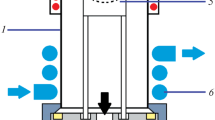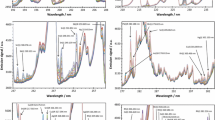Abstract
A fully automated focused infrared microashing sample preparation system was proposed for preparation of biological samples with high organic matter content for the determination of multiple elements combined with inductively coupled plasma optical emission spectroscopy and inductively coupled plasma mass spectrometry. The whole ashing procedure, including sample transfer, carbonization and oxidation of the sample, dissolution of ash, constant volume control, and homogenization of the solution, was automatically controlled. Gold-plated infrared tubes were used to produce and focus infrared radiation to heat the sample. Ozone was used to accelerate the carbonization of samples at a lower temperature to avoid the production of large amounts of empyreumatic oil. In addition, the self-designed double-layer tube serves as a site for ashing and carbonization of the sample and as a container for dissolving ash, as well as for holding the solution. This is the only container in the entire system to reduce the risk of pollution. Eight biological certified reference materials were used as examples to evaluate the performance of the proposed device. A sample ashing pretreatment cycle, from solid sample to liquid solution, took only 40 min and simultaneously treated 12 samples. Except for individual results, the relative errors between the certified values and recorded values for 38 micro and trace elements, including Ca, Mg, Na, P, Li, Be, Sc, Ti, V, Mn, Co, Ni, Cu, Zn, Rb, Sr, Y, Mo, Ag, Cs, Ba, Tl, Th, U, and rare earth elements, were typically less than 30%. The relative standard deviations for five determinations were typically less than 15%.

Automated dry ashing sample preparation system. ICP inductively coupled plasma


Similar content being viewed by others
References
Steehler JK. Sample preparation techniques in analytical chemistry (Mitra, Somenath). J Chem Educ. 2004;81:199. https://doi.org/10.1021/ed081p199.
Bizzi CA, Pedrotti MF, Silva JS, Barin JS, Nóbrega JA. Microwave-assisted digestion methods: towards greener approaches using plasma-based techniques. J Anal At Spectrom. 2017;32:1448–66. https://doi.org/10.1039/C7JA00108H.
Pereira LSF, Frohlich AC, Duarte FA, Burrow RA, Muller EI. Determination of halogens and sulfur in pitch from crude oil by plasma-based techniques after microwave-induced combustion. J Anal At Spectrom. 2015;30:1822–7. https://doi.org/10.1039/C5JA00143A.
Barin JS, Mello PA, Mesko MF, Duarte FA, Flores EM. Determination of elemental impurities in pharmaceutical products and related matrices by ICP-based methods: a review. Anal Bioanal Chem. 2016;408:4547–66. https://doi.org/10.1007/s00216-016-9471-6.
Costa VC, Picoloto RS, Hartwig CA, Mello PA, Flores EM. Feasibility of ultra-trace determination of bromine and iodine in honey by ICP-MS using high sample mass in microwave-induced combustion. Anal Bioanal Chem. 2015;407:7957–64. https://doi.org/10.1007/s00216-015-8967-9.
Matusiewicz H. Sample decomposition techniques in inorganic trace elemental analysis. In: Baranowska B, editor. Handbook of trace analysis: fundamentals and applications. Cham: Springer; 2016. p. 75–122.
Shen K, Zhang N, Yang X, Li Z, Zhang Y, Zhou T. Dry ashing preparation of (quasi)solid samples for the determination of inorganic elements by atomic/mass spectrometry. Appl Spectrosc Rev. 2015;50:304–31. https://doi.org/10.1080/05704928.2014.986735.
Yamada N. Kinetic energy discrimination in collision/reaction cell ICP-MS: theoretical review of principles and limitations. Spectrochim Acta Part B At Spectrosc. 2015;110:31–44. https://doi.org/10.1016/j.sab.2015.05.008.
Grindlay G, Mora J, de Loos-Vollebregt M, Vanhaecke F. A systematic study on the influence of carbon on the behavior of hard-to-ionize elements in inductively coupled plasma–mass spectrometry. Spectrochim Acta Part B At Spectrosc. 2013;86:42–9. https://doi.org/10.1016/j.sab.2013.05.002.
Avila Orozco FD, Kovachev N, Aguirre Pastor MÁ, Domini CE, Fernández Band BS, Canals Hernández A. Analysis of metals and phosphorus in biodiesel B100 from different feedstock using a Flow Blurring(®) multinebulizer in inductively coupled plasma-optical emission spectrometry. Anal Chim Acta. 2014;827:15–21. https://doi.org/10.1016/j.aca.2014.04.016.
Enders A, Lehmann J. Comparison of wet-digestion and dry-ashing methods for total elemental analysis of biochar. Commun Soil Sci Plant Anal. 2012;43:1042–52. https://doi.org/10.1080/00103624.2012.656167.
Azcue J, Mudroch A. Comparison of different washing, ashing, and digestion methods for the analysis of trace elements in vegetation. Int J Environ Anal Chem. 1994;57:151–62. https://doi.org/10.1080/03067319408027420.
Zhang N, Li Z, Zheng J, Yang X, Shen K, Zhou T, et al. Multielemental analysis of botanical samples by ICP-OES and ICP-MS with focused infrared lightwave ashing for sample preparation. Microchem J. 2017;134:68–77. https://doi.org/10.1016/j.microc.2017.05.006.
Revelli JF, Disalvo FJ. Tantalum disulfide (TaS2) and its intercalation compounds. In: Murphy DW, Interrante LV, editors. Inorganic syntheses: nonmolecular solids, vol 30. Hoboken: Wiley; 1979. p. 155–69. https://doi.org/10.1002/9780470132616.ch32.
Capelo-Martinez JL, Ximenez-Embun P, Madrid Y, Camara C, Capelo-Martínez JL, Ximénez-Embún P, et al. Advanced oxidation processes for sample treatment in atomic spectrometry. Trends Anal Chem. 2004;23:331–40. https://doi.org/10.1016/s0165-9936(04)00401-7.
General Administration of Quality Supervision, Inspection and Quarantine of the People’s Republic of China. Laboratory sintered (fritted) filters-Porosity grading, classification and designation. National Standard of China, Standard No.GB/T 11415. 1989. http://www.gb688.cn/bzgk/gb/newGbInfo?hcno=5966CEFF486436ABA16B94F6BAABF8FC.
Novotnik B, Zuliani T, Martinčič A, Ščančar J, Milačič R. Effective reduction of polyatomic interferences produced by high chloride and carbon concentrations in determination of Cr(VI) by FPLC-ICP-MS. J Anal At Spectrom. 2012;27:488. https://doi.org/10.1039/c2ja10270f.
Gleit CE, Holland WD. Use of electrically excited oxygen for the low temperature decomposition of organic substances. Anal Chem. 1962;34:1454–7. https://doi.org/10.1021/ac60191a031.
Hill AD, Patterson KY, Veillon C, Morris ER. Digestion of biological materials for mineral analyses using a combination of wet and dry ashing. Anal Chem. 1986;58:2340–2. https://doi.org/10.1021/ac00124a049.
IUPAC. Compendium of chemical terminology, 2nd ed. (the "Gold Book"). Compiled by A. D. McNaught and A. Wilkinson. Oxford: Blackwell Scientific Publications; 1997. XML on-line corrected version: http://goldbook.iupac.org (2006-) created by M. Nic, J. Jirat, B. Kosata; updates compiled by A. Jenkins. https://doi.org/10.1351/goldbook
Batakliev T, Georgiev V, Anachkov M, Rakovsky S, Rakovsky S. Ozone decomposition. Interdiscip Toxicol. 2014; https://doi.org/10.2478/intox-2014-0008.
Dhandapani B, Oyama ST. Gas phase ozone decomposition catalysts. Appl Catal B Environ. 1997;11:129–66. https://doi.org/10.1016/S0926-3373(96)00044-6.
Peshkovsky AS, Peshkovsky SL. Acoustic cavitation theory and equipment design principles for industrial applications of high-intensity ultrasound. Nova, Hauppauge. 2010.
Freiser H, Nancollas GH. Compendium of analytical nomenclature (definitive rules 1987). 2nd ed. Oxford: Blackwell; 1987. p. 8–11.
Ministry of Land and Resources of the People's Republic of China. Specification of regional ecogeochemistry assessment. Geology and mineral industry standard of China. Standard No. DZ/T 0289. 2015. http://www.mlr.gov.cn/zwgk/zytz/201510/t20151013_1383877.htm.
Funding
This study was funded by the National Instrumentation Program of China (grant no. 2013YQ510391), the Shaanxi Province Science and Technology Project (grant no. 2015GY054), the National Science Fund of China (grant no. 21575113), the Specialized Research Fund for the Doctoral Program of Higher Education (grant no. 20126101110013), and the Scientific Research Foundation of Shaanxi Provincial Key Laboratory (grant nos 15JS100 and 16JS099).
Author information
Authors and Affiliations
Corresponding author
Ethics declarations
Conflict of interest
The authors declare that they have no competing interests.
Ethics statement
This article does not contain any studies with human participants or animals performed by any of the authors. The human hair sample used in this work was a Chinese national certified reference standard material, which was purchased from a commercial institute in China.
Rights and permissions
About this article
Cite this article
Zhang, N., Zheng, J. Fully automated focused infrared microashing combined with use of ICP-based instruments for rapid analysis of multiple elements in biological samples. Anal Bioanal Chem 410, 1489–1499 (2018). https://doi.org/10.1007/s00216-017-0790-z
Received:
Revised:
Accepted:
Published:
Issue Date:
DOI: https://doi.org/10.1007/s00216-017-0790-z




